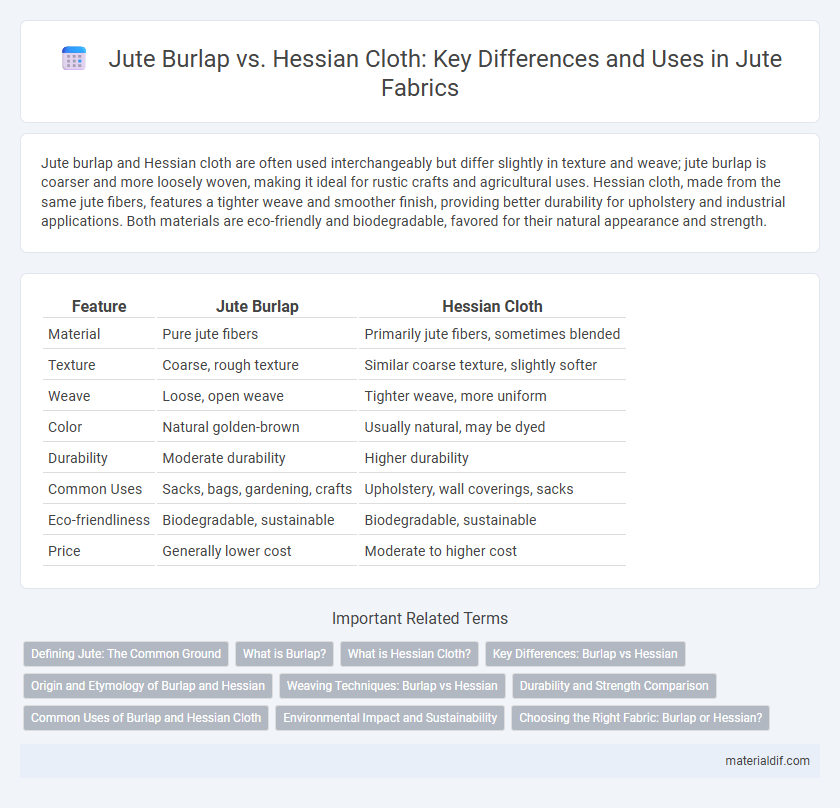Jute burlap and Hessian cloth are often used interchangeably but differ slightly in texture and weave; jute burlap is coarser and more loosely woven, making it ideal for rustic crafts and agricultural uses. Hessian cloth, made from the same jute fibers, features a tighter weave and smoother finish, providing better durability for upholstery and industrial applications. Both materials are eco-friendly and biodegradable, favored for their natural appearance and strength.
Table of Comparison
| Feature | Jute Burlap | Hessian Cloth |
|---|---|---|
| Material | Pure jute fibers | Primarily jute fibers, sometimes blended |
| Texture | Coarse, rough texture | Similar coarse texture, slightly softer |
| Weave | Loose, open weave | Tighter weave, more uniform |
| Color | Natural golden-brown | Usually natural, may be dyed |
| Durability | Moderate durability | Higher durability |
| Common Uses | Sacks, bags, gardening, crafts | Upholstery, wall coverings, sacks |
| Eco-friendliness | Biodegradable, sustainable | Biodegradable, sustainable |
| Price | Generally lower cost | Moderate to higher cost |
Defining Jute: The Common Ground
Jute, a natural fiber derived from the Corchorus plant, forms the foundation of both burlap and hessian cloth, sharing essential properties like strength, breathability, and biodegradability. Jute burlap is typically coarser with a looser weave, often used in rustic bags and upholstery, while hessian cloth has a finer, tighter weave favored in upholstery, sacks, and industrial applications. Both textiles harness the eco-friendly and sustainable benefits of jute fibers, making them popular choices in packaging, agriculture, and textile industries.
What is Burlap?
Burlap is a coarse, woven fabric made from jute fibers, known for its durability and breathability, commonly used in packaging, upholstery, and gardening. It is often confused with Hessian cloth, which is also made from jute but typically features a finer weave and smoother finish, making it suitable for decorative and craft applications. Burlap's rough texture and strength make it ideal for industrial purposes, whereas Hessian offers versatility with a more refined appearance.
What is Hessian Cloth?
Hessian cloth is a coarse woven fabric made from jute fibers, commonly used in sacks, upholstery, and garden applications. It is often referred to as burlap in North America, but Hessian typically has a tighter weave and a smoother finish. This natural, biodegradable material is valued for its durability, breathability, and eco-friendly properties.
Key Differences: Burlap vs Hessian
Jute burlap and hessian cloth are both coarse fabrics made from jute fibers, but they differ primarily in weave and finish, with burlap featuring a looser, more open weave and hessian a tighter, smoother texture. Burlap is commonly used for sacks, upholstery, and gardening due to its breathability and rougher surface, whereas hessian cloth is favored for decorative purposes, crafts, and upholstery because of its finer weave and uniform appearance. The color of burlap tends to be lighter and more natural, while hessian typically has a darker, richer brown tone resulting from specific processing methods.
Origin and Etymology of Burlap and Hessian
Jute burlap and Hessian cloth both derive from natural fibers, but their names reflect distinct historical and geographical origins. Burlap, believed to originate from the Middle English word "borel" meaning coarse cloth, refers to a rough, woven fabric primarily made from jute or hemp. Hessian, named after the German region of Hesse, historically described a similar coarse fabric used for military uniforms, emphasizing regional nomenclature versus functional textile use.
Weaving Techniques: Burlap vs Hessian
Jute burlap and Hessian cloth differ primarily in their weaving techniques, which affect texture and strength. Burlap is typically woven with a looser, coarser weave, resulting in a rougher texture ideal for packaging and gardening. Hessian cloth features a tighter, finer weave that enhances durability and provides a smoother finish, commonly used in upholstery and fashion applications.
Durability and Strength Comparison
Jute burlap and Hessian cloth both derive from natural jute fibers but differ in weave density and finish, impacting durability and strength. Hessian cloth generally exhibits a tighter weave and heavier weight, resulting in higher tensile strength and better resistance to wear, making it ideal for heavy-duty applications. Jute burlap, while slightly less robust, offers greater flexibility and breathability, suitable for packaging and agricultural uses where moisture permeability and lightweight material are advantageous.
Common Uses of Burlap and Hessian Cloth
Jute burlap is primarily used for packaging agricultural goods, such as sacks for potatoes, coffee beans, and grains, because of its coarse texture and breathability. Hessian cloth, a finer grade of jute fabric, is commonly employed in upholstery, curtains, and craft projects due to its smoother finish and aesthetic appeal. Both materials are eco-friendly, biodegradable, and widely favored in interior decor and gardening applications for sustainable solutions.
Environmental Impact and Sustainability
Jute burlap and hessian cloth, both derived from the jute plant, offer eco-friendly alternatives to synthetic fabrics due to their biodegradability and renewable sourcing. Jute burlap typically involves minimal chemical processing, reducing environmental pollutants compared to some hessian cloth variants treated for durability or aesthetics. The sustainability of both materials is enhanced by jute's fast growth cycle and low water requirements, positioning them as viable options for environmentally conscious textile production.
Choosing the Right Fabric: Burlap or Hessian?
Jute burlap and hessian cloth are both durable, eco-friendly fabrics made from natural jute fibers, but their weave and finish distinguish their best applications. Burlap typically has a coarser weave, ideal for rustic, heavy-duty uses like upholstery and gardening, while hessian features a finer, smoother texture favored for fashion and interior decor. Selecting the right fabric depends on project requirements: burlap offers rugged strength and breathability, whereas hessian provides a refined look with similar sustainability benefits.
Jute Burlap vs Hessian Cloth Infographic

 materialdif.com
materialdif.com